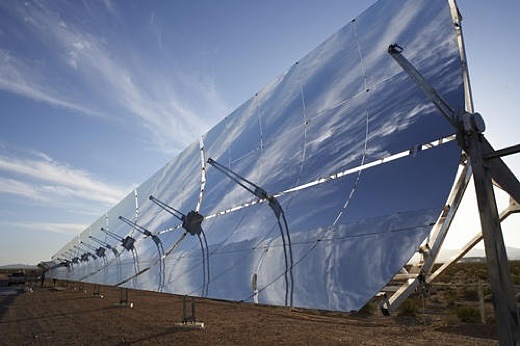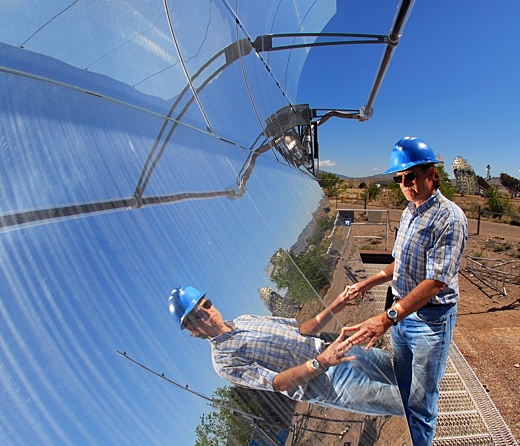 Image above: Arizona to get billion dollar solar thermal power plant provided by Albiasa Solar of Spain. From (http://www.nicernews.com/2009/04/arizona-to-get-billion-dollar-solar-thermal-power-plant/)
By Coco Zickos on 8 April 2010 in The Garden Island -
(http://thegardenisland.com/news/local/article_82ea5b94-43b5-11df-bb62-001cc4c03286.html)
Image above: Arizona to get billion dollar solar thermal power plant provided by Albiasa Solar of Spain. From (http://www.nicernews.com/2009/04/arizona-to-get-billion-dollar-solar-thermal-power-plant/)
By Coco Zickos on 8 April 2010 in The Garden Island -
(http://thegardenisland.com/news/local/article_82ea5b94-43b5-11df-bb62-001cc4c03286.html)
Farming sunshine may not become a reality for Kaua‘i after all.
Almost three months after signing a lease to operate a $70-million, 10-megawatt concentrated solar thermal power plant on some 100 acres between Waimea and Kekaha, Pacific Light & Power has been unable to move forward with a Purchase Power Agreement with Kaua‘i Island Utility Cooperative, said the company’s Chief Executive Officer Dick Roth.
The cost to members would have been “higher than anything we’ve been looking at,” said KIUC President and Chief Executive Officer Randy Hee. “It puts us at some risks which we were unwilling to accept.”
The project — which could potentially bring power to some 8,000 single-family homes, offset around 15,000 tons of carbon dioxide and save the island from importing approximately one million gallons of diesel annually, according to Roth — has not been killed, and talks are still underway, Hee said. But KIUC stands firm in wanting to “benefit our members” by not raising costs “dramatically,” he said.
Although the exact fee increase to members could not be confirmed, PLP’s goal was to sustain a fixed price, reducing the island’s dependency on foreign oil and its fluctuating costs. In fact, the cost per barrel of the finite resource has more than doubled since January 2009 from around $37 to nearly $90 per barrel Wednesday.
“Everybody agrees in the value of indigenous power and it’s worth it in the beginning to pay a little bit extra for power that was created on the island,” Roth said, adding the company is “not going to make a lot of money on this if it ever gets going.
“We wanted to bring down the cost as low as we possibly could,” he said.
But it’s “tricky,” because “we think that the price we brought in is really a good price” and “would save the members money, but KIUC looks at numbers differently,” Roth said. The situation is based upon “two different assumptions.”
Oil prices may not climb to the levels PLP is predicting, Hee said. And if it the value did not increase to the same capacity the company is assuming, members would “probably be more upset” having the solar energy which would ultimately “raise their rates.”
One person who said he might not be upset with higher rates, as long as they weren’t “exorbitant,” is community activist Bruce Pleas.
“Anytime you do an alternative-energy project your rates are initially going to go up,” he said Thursday. “That’s just the nature of the beast.”
But Pleas added he could “handle an increase” if he knew it would eventually stabilize due to utilizing resources other than volatile-priced oil.
Renewable energies are still very important, but KIUC wants to be sure the projects are “going to be done smartly” and will not be “high-risk” or “high-cost,” Hee said.
So while Roth and Hee had nothing but kind words to say about one another, the two parties have certainly “come to an impasse,” Roth said.
“We’re hopeful maybe they can still get something going,” Hee said.
In the meantime, two photovoltaic projects — one designed to produce one megawatt of power and another a two-megawatt facility — plan to be underway by the end of the year, Hee said. But, the utility is still far from its 50-percent, renewable-energy goal by 2023.
In 2009, around 14 percent of the island was powered by sources other than fossil fuel, according to an interview earlier this year with KIUC Engineer Steve Rymsha.
“I don’t know what it’s going to take to make it work,” Roth said. “We worked so hard to do this the right way for the island.”
Albiasa to supply HI solar plant
 Image above: The Mohave Sun Power company is planning a project in Mohave County that could begin construction in the fourth quarter of 2010.. From (http://cleantechnica.com/2009/05/13/worlds-largest-solar-thermal-plant-340mw-planned-for-arizona)
By James Cartledge on 9 April 2010 in BrighterEnergy -
(http://www.brighterenergy.org/8227/news/solar/albiasa-to-supply-technology-for-hawaiis-largest-solar-plant)
Renewable energy developer Pacific Light & Power has selected solar thermal technology from Spanish-owned firm Albiasa Corporation to build Hawaii’s largest solar power facility.
Image above: The Mohave Sun Power company is planning a project in Mohave County that could begin construction in the fourth quarter of 2010.. From (http://cleantechnica.com/2009/05/13/worlds-largest-solar-thermal-plant-340mw-planned-for-arizona)
By James Cartledge on 9 April 2010 in BrighterEnergy -
(http://www.brighterenergy.org/8227/news/solar/albiasa-to-supply-technology-for-hawaiis-largest-solar-plant)
Renewable energy developer Pacific Light & Power has selected solar thermal technology from Spanish-owned firm Albiasa Corporation to build Hawaii’s largest solar power facility. The 10MW Kauai 1 project is expected to begin construction toward the end of 2010 on 100 acres of dormant farmland between Kekaha and Waimei on Kauai, Hawaii’s fourth largest island.
The project will be the first utility-scale power plant on the island of Kauai, with PLP currently negotiating a power purchase agreement with Kauai Island Utility Cooperative to buy generated electricity.
PLP has sent Albiasa a letter of intent to use its technology on the facility, which will use 1,488 parabolic trough mirrors to focus sunlight on a transfer fluid, that then drives a turbine to generate power.
Albiasa, a San Francisco-based subsidiary of Albiasa Solar, has already completed “substantial” preliminary engineering, and is now working on finalizing the project’s design.
The facility is expected to begin operations in late 2011, providing enough power for Kauai Island Utility Cooperative to supply the equivalent of 8,000 homes.
Pacific Light & Power, which is based on the island at Anahola, specializes in hybrid renewable power generation projects, and the Kauai project design allows for three hours of energy storage within the transfer fluid to balance out the intermittency of the solar generation.
Organic Rankine
Nevada firm Ram Power, Inc., will provide its organic rankine cycle system to convert the thermal energy into electrical energy.
The system includes traditional steam turbine equipment with an organic rankine cycle, a heat exchange system which generates electricity from lower temperature fluids to maintain the power output from the solar plant for a longer period.
The technology allows the solar plant to smooth over the periods when the weather obscures the sun, and allow a few hours of generation after the sun has set.
Dick Roth, CEO of Pacific Light & Power, said: “Incorporating Albiasa technology and engineering services will help us deliver a high yield and cost effective clean energy source and ultimately enable us to deliver better rates for our customers.”
Albiasa, which has so far provided 63MW of projects with its parabolic trough technology, claimed the system offered a 30% cost reduction compared to comparably technology.
“Commencing this 10 MW field in Kauai is a great step forward, not only for the renewable energy resources provided to the residents of Hawaii, but as a testament to the reliability of today’s solar technology,” said Jesse Tippett, managing director of Albiasa Corporation.
“This project shows that we can replicate smaller solar farms and projects across the U.S. and further the growing adoption of renewable energy.”
.
1 comment :
Wow, I was so excited about this project! KIUC fails to realize that although there will be a member price increase, at least that is cash that will remain on island...seems we live in a plain ole dumb world! -Ronald James
Post a Comment